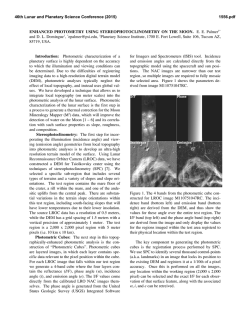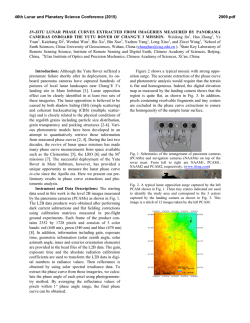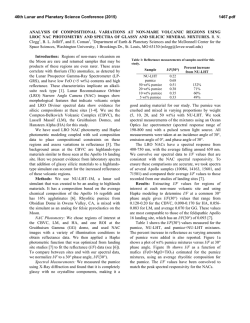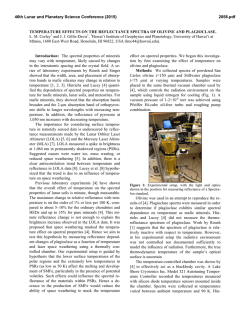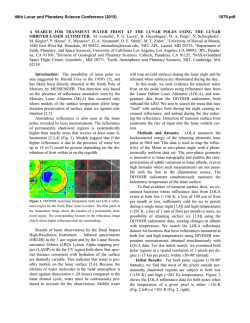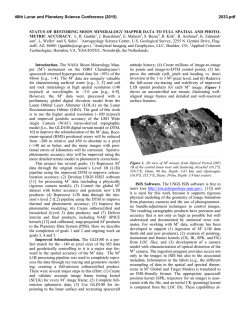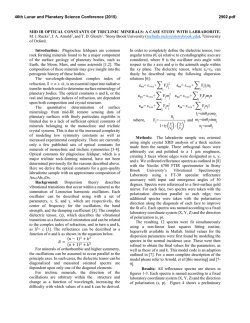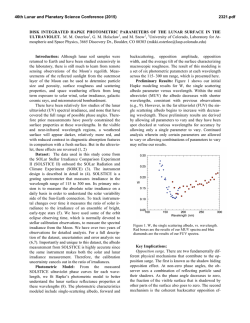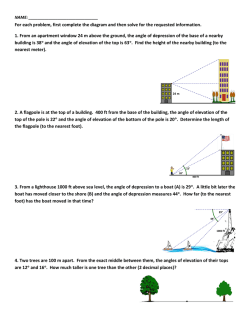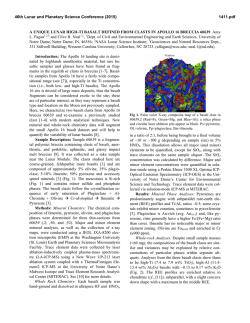
2841
46th Lunar and Planetary Science Conference (2015) 2841.pdf INVESTIGATING SURFACE TEXTURES USING LROC NAC PHOTOMETRY. A. K. Boyd1, M. S. Robinson1, H. Sato1, 1School of Earth and Space Exploration, Arizona State University, Tempe, AZ, USA ([email protected]) Introduction: The Moon revolves underneath the orbital plane of the Lunar Reconnaissance Orbiter (LRO) permitting repeat imaging of any location under different illumination geometries. These multitemporal observations (since June of 2009) provide a robust dataset for photometric analysis. Each Lunar Reconnaissance Orbiter Camera (LROC) Narrow Angle Camera (NAC) has a 2.85° field-of-view [1], thus the photometric angles of incidence (angle of sub-solar vector relative to the surface normal), emission (angle of camera boresight vector relative to the surface normal), and phase (angle between emission and incidence vectors) [2], vary dominantly from topography in a single image. To allow quantitative comparisons of reflectance values from spatially dispersed NAC images, we derived an empirical global photometric solution from ~740,000 LROC NAC image tiles (2.5km x 2.5km) [3]. We call this the Mean Moon Photometric Function (MMPF) [EQ1]. The difference from the MMPF at different phase angles is used to highlight differences in surfaces properties across the Moon. !I$ log # & = '2.98 ' 0.011g ' 0.81cos ( e) +1.32cos (i) "F% EQ1: Mean Moon Photometric Function (MMPF) used to normalize NAC images. I/F depends on phase (g), emission (e) and incidence (i) angles. Method: LROC NAC images for a given location were binned to 5 meters per pixel and photometrically normalized to standard viewing geometry (i=30,e=0,g=30) using the MMPF and LROC NAC Digital Terrain Models (DTMs). The images were then grouped into phase angle bins: 15° (0°<g≤30°), 45° (30°<g≤60°), and 75° (60°<g≤90°). Phase Maps: The phase bins are used to compute the median normalized reflectance and relative standard deviation at each pixel location for that bin. Any location with a relative standard deviation greater than 25% is thrown out to ensure a robust map. The final product is a three band image with R=75°, G=45°, and B=15° [Fig. 1]. The phase maps represent texture of the surface at pixel scales and smaller. If the normalized 75° bin has lower reflectance than the 45° or 15° bins, the area is considered to be rougher than the mean-Moon. Conversely, if the normalized reflectance of the 75° bin is greater than the 45° or 15° bins, then the area is interpreted to be smoother than the mean-Moon. Fig. 1: Phase maps of the Apollo 15 SIVB impact (above) and the Apollo 16 landing site (below). The RGB images are normalized reflectance (i=30°, e=0°,g=30°) from different phase bins. Red=75°, Green=45°, Blue=15°. Images have different stretches; widths are 1 km. Reflectance vs Phase: Using the phase maps, areas were mapped by hand, and the mean values for each phase bin were calculated for the mapped location including a representative area for the whole scene [Fig. 2]. 46th Lunar and Planetary Science Conference (2015) 2841.pdf Fig. 2: Normalized reflectance of the phase bins for the Apollo 15 SIVB impact location (left) and Apollo 16 landing area (right). The normalized reflectance show that overall the Apollo 16 blast zone is (right;red) smoother than the SIVB impact ejecta (left;red). NAC Photometric Sites: For this study, we have derived two photometric sites near the Apollo 16 landing site and the Apollo 15 S-IVB impact site. The Apollo 16 landing photometric site has 132 NAC observations with photometric angles ranging from 8° to 88° incidence, 0° to 66° emission , and 7° to 97° phase angle. Meanwhile the Apollo 15 SIVB impact site has 69 total observations with photometric angles ranging from 2° to 72° incidence, 0° to 34° emission, and 0° to 94° phase angle. Results and Discussion: For a given area, if the normalized reflectance for the bins are all elevated or suppressed equally, then the area has the same photometric properties as the mean-Moon, but has higher or lower reflectance. Rougher terrains cast more visible shadows on the surface at higher phase angles than smoother terrains. The phase angles at which the shadows start appearing correlates to the degree of roughness, with steeper terrains having more shadows visible at smaller phase angles. However the scale of the roughness can not be determined beyond the pixel size. The NAC images in this study were binned to the DTM resolutions of 5 m per pixel. The phase maps and differences from the MMPF can be used to investigate surface roughness differences at < 5-m scale. The Apollo 16 blast zone is smoother than the mean-Moon in agreement with other blast zone analysis [4], while the Apollo 16 landing site outside the blast zone was found to match the mean-Moon photometric properties. The Apollo 15 SIVB impact ejecta is rougher than the mean-Moon and similar to small fresh impact craters. The phase technique can resolve fine scale (<5m) surface properties and highlight areas of interest. References: [1] Robinson et al. (2010) Space Science Rev. 150: 81-124. [2] Hapke B. (2012) Cambridge University Press. [3] Boyd (2014) LPSC 45 #2826. [4] Clegg et al. (2014) LPSC 45 #1625.
© Copyright 2025
